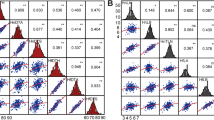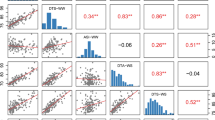Abstract
Flowering time is a fundamental quantitative trait in maize that has played a key role in the postdomestication process and the adaptation to a wide range of climatic conditions. Flowering time has been intensively studied and recent QTL mapping results based on diverse founders suggest that the genetic architecture underlying this trait is mainly based on numerous small-effect QTL. Here, we used a population of 684 progenies from five connected families to investigate the genetic architecture of flowering time in elite maize. We used a joint analysis and identified nine main effect QTL explaining approximately 50 % of the genotypic variation of the trait. The QTL effects were small compared with the observed phenotypic variation and showed strong differences between families. We detected no epistasis with the genetic background but four digenic epistatic interactions in a full 2-dimensional genome scan. Our results suggest that flowering time in elite maize is mainly controlled by main effect QTL with rather small effects but that epistasis may also contribute to the genetic architecture of the trait.






Similar content being viewed by others
References
Austin DF, Lee M (1996) Genetic resolution and verification of quantitative trait loci for flowering and plant height with recombinant inbred lines of maize. Genome 39:957–968
Bäurle I, Dean C (2006) The timing of developmental transitions in plants. Cell 125:655–664
Beavis WD, Smith OS, Grant D, Fincher T (1994) Identification of quantitative trait loci using a small sample of topcrossed and F4 progeny from maize. Crop Sci 34:882–896
Blanc G, Charcosset A, Mangin B, Gallais A, Moreau L (2006) Connected populations for detecting quantitative trait loci and testing for epistasis: an application in maize. Theor Appl Genet 113:206–224
Bomblies K, Wang RL, Ambrose BA, Schmidt RJ, Meeley RB et al (2003) Duplicate FLORICAULA/LEAFY homologs zfl1 and zfl2 control inflorescence architecture and flower patterning in maize. Development 130:2385–2395
Buckler ES, Holland JB, Bradbury PJ, Acharya CB, Brown PJ et al (2009) The genetic architecture of maize flowering time. Science 325:714–718
Camus-Kulandaivelu L, Veyrieras JB, Madur D, Combes V, Fourmann M et al (2006) Maize adaptation to temperate climate: relationship between population structure and polymorphism in the Dwarf8 gene. Genetics 172:2449–2463
Carlborg Ö, Haley CS (2004) Epistasis: too often neglected in complex trait studies? Nat Rev Genet 5:618–625
Chardon F, Virlon B, Moreau L, Falque M, Joets J, Decousset L, Murigneux A, Charcosset A (2004) Genetic architecture of flowering time in maize as inferred from QTL meta-analysis and synteny conservation with the rice genome. Genetics 168:2169–2185
Colasanti J, Yuan Z, Sundaresan V (1998) The indeterminate gene encodes a zinc finger protein and regulates a leaf-generated signal required for the transition to flowering in maize. Cell 93:593–603
Colasanti J, Tremblay R, Wong AY, Coneva V, Kozaki A et al (2006) The maize INDETERMINATE1 flowering time regulator defines a highly conserved zinc finger protein family in higher plants. BMC Genomics 7:158–175
Coles ND, McMullen MD, Balint-Kurti PJ, Pratt RC, Holland JB (2010) Genetic control of photoperiod sensitivity in maize revealed by joint multiple population analysis. Genetics 184:799–822
Danilevskaya ON, Meng X, Hou Z, Ananiev EV, Simmons CR (2008) A genomic and expression compendium of the expanded PEBP gene family from maize. Plant Physiol 146:250–264
Dellaporta SL, Wood J, Hicks JB (1983) A plant DNA minipreparation: version II. Plant Mol Biol Rep 1:19–21
Doerge RW, Churchill GA (1996) Permutation tests for multiple loci affecting a quantitative character. Genetics 142:285–294
Ducrocq S, Giauffret C, Madur D, Combes V, Dumas F, Jouanne S, Coubriche D, Jamin P, Moreau L, Charcosset A (2009) Fine mapping and haplotype structure analysis of a major flowering time quantitative trait locus on maize chromosome 10. Genetics 183:1555–1563
El-Lithy ME, Bentsink L, Hanhart CJ, Ruys GJ, Rovito D, Broekhof JLM, van der Poel HJA, van Eijk MJT (2006) New Arabidopsis recombinant inbred line populations genotyped using SNPWave and their use for mapping flowering-time quantitative trait loci. Genetics 172:1867–1876
Fisher RA (1918) The correlation between relatives on the supposition of Mendelian inheritance. Trans Roy Soc Edin 52:399–433
Goodman MM (1988) The history and evolution of maize. CRC Crit Rev Plant Sci 7:197–220
Gower JC (1966) Some distance properties of latent root and vector methods used in multivariate analysis. Biometrika 53:325–338
Hallauer AR, Russell WA, Lamkey KR (1988) Corn Breeding. In: Sprague GF, Dudley JW (eds) Corn and Corn Improvement. Agronomy, vol 18. Am. Soc. of Agron, Madison, pp 463–564
Hayama R, Yokoi S, Tamaki S, Yano M, Shimamoto K (2003) Adaptation of photoperiodic control pathways produces short-day flowering in rice. Nature 422:719–722
Holland JB, Portyanko VA, Hoffmann DL, Lee M (2002) Genomic regions controlling vernalization and photoperiod responses in oat. Theor Appl Genet 105:113–126
Jannink JL, Jansen RC (2001) Mapping epistatic quantitative trait loci with one-dimensional genome searches. Genetics 157:445–454
Lander ES, Botstein D (1989) Mapping mendelian factors underlying quantitative traits using RFLP linkage maps. Genetics 121:185–199
Liu W, Gowda M, Steinhoff J, Maurer HP, Würschum T et al (2011) Association mapping in an elite maize breeding population. Theor Appl Genet 123:847–858
Lynch M, Walsh B (1998) Genetics and analysis of quantitative traits. Sinauer Assoc, Sunderland
Maurer HP, Melchinger AE, Frisch M (2008) Population genetic simulation and data analysis with Plabsoft. Euphytica 161:133–139
McMullen MD, Kresovich S, Villeda HS, Bradbury P, Li H et al (2009) Genetic properties of the maize nested association mapping population. Science 325:737–740
Mechin V, Argillier O, Hébert Y, Guingo E, Moreau L et al (2001) Genetic analysis and QTL mapping of cell wall digestibility and lignifications in silage maize. Crop Sci 41:690–697
Melchinger AE, Utz HF, Schön CC (1998) Quantitative trait locus (QTL) mapping using different testers and independent population samples in maize reveals low power of QTL detection and large bias in estimates of QTL effects. Genetics 149:383–403
Myles S, Peiffer J, Brown PJ, Ersoz ES, Zhang Z et al (2009) Association mapping: critical considerations shift from genotyping to experimental design. Plant Cell 21:2194–2202
R Development Core Team (2010) R: A language and environment for statistical computing. http://www.R-project
Rebai A, Goffinet B (1993) Power of tests for QTL detection using replicated progenies derived from a diallel cross. Theor Appl Genet 86:1014–1022
Reif JC, Maurer HP, Korzun V, Ebmeyer E, Miedaner T et al (2011) Mapping QTLs with main and epistatic effects underlying grain yield and heading time in soft winter wheat. Theor Appl Genet 123:283–292
Salvi S, Sponza G, Morgante M, Tomes D, Niu X et al (2007) Conserved noncoding genomic sequences associated with a flowering-time quantitative trait locus in maize. PNAS 104:11376–11381
SAS Institute (2008) SAS/STAT 9.2 user’s guide. SAS Inst., Cary
Schnell FW (1965) Die Covarianz zwischen Verwandten in einer genorthogonalen Population I. Allgemeine Theorie. Biom Z 7:1–49
Steinhoff J, Liu W, Maurer HP, Würschum T, Longin FH et al (2011) Multiple-line cross QTL-mapping in European elite maize. Crop Sci 51:2505–2516
Thornsberry JM, Goodman MM, Doebley H, Kresovich S, Nielsen D, Buckler ES (2001) Dwarf8 polymorphisms associate with variation in flowering time. Nat Genet 28:286–289
Turner A, Beales J, Faure S, Dunford RP, Laurie DA (2005) The pseudo-response regulator Ppd-H1 provides adaptation to photoperiod in barley. Science 310:1031–1034
Utz HF, Melchinger AE, Schön CC (2000) Bias and sampling error of the estimated proportion of genotypic variance explained by quantitative trait loci determined from experimental data in maize using cross validation and validation with independent samples. Genetics 154:1839–1849
Uwatoko N, Onishi A, Ikeda Y, Manabu K, Sasaki A, Matsubata K, Itoh Y, Sano Y (2008) Epistasis among the three major flowering time genes in rice: coordinate changes of photoperiod basic vegetative growth and optimum photoperiod. Euphytica 163:167–175
Veldboom LR, Lee M (1996) Genetic mapping of quantitative trait loci in maize in stress and nonstress environments: II. Plant height and flowering. Crop Sci 36:1320–1327
Verhoeven KJF, Jannink JL, McIntyre LM (2006) Using mating designs to uncover QTL and the genetic architecture of complex traits. Heredity 96:139–149
Wright S (1978) Evolution and genetics of populations, variability within and among natural populations, vol 4. The University of Chicago Press, Chicago, p 91
Würschum T (2012) Mapping QTL for agronomic traits in breeding populations. Theor Appl Genet 125:201–210
Würschum T, Maurer HP, Schulz B, Möhring J, Reif JC (2011) Genome-wide association mapping reveals epistasis and genetic interaction networks in sugar beet. Theor Appl Genet 123:109–118
Würschum T, Liu W, Gowda M, Maurer HP, Fischer S et al (2012a) Comparison of biometrical models for joint linkage association mapping. Heredity 108:332–340
Würschum T, Liu W, Maurer HP, Abel S, Reif JC (2012b) Dissecting the genetic architecture of agronomic traits in multiple segregating populations in rapeseed (Brassica napus L.). Theor Appl Genet 124:153–161
Xue W, Yongzhong X, Weng X, Zhao Y, Tang W et al (2008) Natural variation in Ghd7 is an important regulator of heading date and yield potential in rice. Nat Genet 40:761–767
Acknowledgments
This research was conducted within the Biometric and Bioinformatic Tools for Genomics based Plant Breeding project of the GABI –FUTURE initiative. We are grateful to the editor and two anonymous reviewers for their helpful comments and suggestions. This paper is dedicated to Dr. H.F. Utz, whose enthusiasm for QTL mapping inspired our research.
Author information
Authors and Affiliations
Corresponding author
Additional information
Communicated by J. Yu.
J. Steinhoff and W. Liu contributed equally to this work.
Electronic supplementary material
Below is the link to the electronic supplementary material.
Rights and permissions
About this article
Cite this article
Steinhoff, J., Liu, W., Reif, J.C. et al. Detection of QTL for flowering time in multiple families of elite maize. Theor Appl Genet 125, 1539–1551 (2012). https://doi.org/10.1007/s00122-012-1933-4
Received:
Accepted:
Published:
Issue Date:
DOI: https://doi.org/10.1007/s00122-012-1933-4




